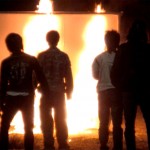Dir. by Apitchatpong Weerasethakul
Mark Peranson’s article at Moving Image Source, “Exquisite Corpus,” is a useful introduction to Apitchatpong “Joe” Weerasethakul’s Primitive project, a collection of shorts, installations, and an in-the-works feature inspired by the director’s new-found interest in reincarnation and, more specifically, by a short book he was given about the many lives of Uncle Boonmee, whose ghosts still haunt the village of Nabua in northeast Thailand. The project also reflects Apitchatpong’s increasing political engagement. Peranson writes:
Beginning with the onset of a famous gun battle between farmer communists and the totalitarian government on August 7, 1965, Nabua was occupied by the Thai Army from the ’60s into the ’80s to suppress communist agitators. The only thing similar to the story of Boonmee is that, in Apichatpong’s words, “the village is also full of repressed memories. . . . It is a place where memories and ideologies are extinct.” It is with the sons of those communists who were tortured or oppressed, or who died during the brutal period of the occupation, that Apichatpong made the works that constitute Primitive. Set in a place whose history has been forgotten by both the country and local inhabitants, the project reimagines Nabua by bringing light to the ghosts of the past through the lost generation of today, while also confronting the current political turmoil in Thailand.
Phantoms of Nabua, which will be installed at the Museum of Contemporary Canadian Art throughout the Toronto International Film Festival as part of the Future Projections program, can be viewed online, but I’d recommend seeing it projected and (hopefully) with surround sound if possible. As has become Joe’s trademark, the ten-minute film is first and foremost a sensory experience. Phantoms takes place at night in a field where a makeshift screen has been assembled, onto which is being projected flashes of lighting that erupt on impact with the ground. (According to Peranson, these are clips from Nabua, another of the shorts from Primitive.) In the foreground, a group of teenage boys, barely visible in the darkness, pass a flaming soccer ball back and forth until it ignites the screen, leaving only the projector, which continues to spray its images into the dark.
There are ways of “decoding” this film, I suppose — the soccer ball as a synecdoche for military armaments, the cinema as documentarian, the hovering florescent light as ghost (or Ghost) — but reducing Joe’s films to points on a symbolic answer key seems beside the point. Watching Phantoms and A Letter to Uncle Boonmee (playing in Wavelengths 5: Une Catastrophe), I was struck by the idea that Aptichatpong is one of the few true heirs to Tarkovsky. They share thematic obsessions, particularly the intersection of personal (autobiography) and national (History) memory, and they’re certainly two of the cinema’s great mystics. More than any of our other great filmmakers today, I see Apitchatpong consistently striving for — and realizing, with breathtaking clarity — Tarkovsky’s ideal, “the film image,” which, as opposed to the intellectually-reducible symbol, “gives the beholder a simultaneous experience of the most complex, contradictory, sometimes even mutually exclusive feelings” (Sculpting in Time, 109).
An example: Another of Apitchatpong’s short films, Mobile Men (2008), part of the Stories on Human Rights Project.
On the YouTube page a well-intentioned commenter offers a point-by-point analysis of what this film means, as if the experience of watching it, especially the last minute, could be so easily expressed in words.
A Letter to Uncle Boonmee is set at a home in the jungles of Nabua, through which Apitchatpong’s camera tracks and pans — floats, really — observing photos of lost relatives on the walls and peering through open windows. On the soundtrack, we hear first one man then another recite Joe’s desire to make a film about the reincarnated lives of Uncle Boonmee. (Later, we also hear one of the men rehearsing his lines and jokingly chastising Joe for screwing up their dialect, which recalls one of my favorite scenes in Syndromes and a Century, when we hear two actors discussing the minutes-long shot they’re currently filming.) The penultimate shot in the film is particularly Tarkovskian. The camera tracks over the home’s roofline, tilts up, looking into the tree tops, and then returns to ground level, where it sees an animal in the far distance — another of Boonmee’s ghosts and also, like Tarkovsky’s horses, a multivalent, shape-shifting image.
A Letter to Uncle Boonmee feels a bit like a sketch for a feature-length film, but, especially in juxtaposition with Phantoms of Nabua, it’s the best thing I’ve seen in 2009. I can’t wait to see the rest of Primitive.
